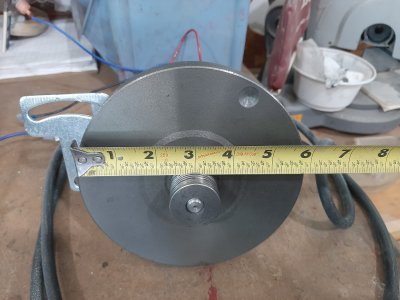Coming up the list is to build a 2x72 sander. I attached a poll here just for fun and curiosity as it seems like this is a popular project for home hobbyists. A friend approached me a couple of months back with some questions and, since then, I have spent too much time spinning my wheels on it, so it is time to move forward. on building one. I was hoping we could design one together and then post the plans in the "Plans" section. As those that have been on committees before, the more people involved,the longer a project takes but at least we will all have some input. There are tons of videos and plans available on line. For me, here are my thoughts and options. You might be in a slightly different, or very similar situation.
I don't have square tubing that slides nicely into other square tubing, which seems to be a common thread with plans on line.
I do have lots of round tubing/pipe/DOM tubing and I have a metal lathe that works better with round stuff than square stuff
I have scrapped a couple of treadmills and have the motors and controls boards (read variable speed, 2-3 hp )
These sanders have been mentioned several times for sharpening tool bits...right up our alley
I think the round pipe lends itself to a tilting sander better/more easily done than with square tubing (but that mechanism does not look too difficult either)
So, rather than post pics after it is done, I thought I would see what the group has to say. And wondering if there is interest in making this a group project. I lack CAD skills but am trying so won't even post what I have so far. but eventually, plans will need to be drawn to post in that forum. Mine will be awful, functional, but awful....just saying!
For now, start with the poll. I would be interested in seeing who has built one and if they used plans, which plans. or just winged it. I would guess "winged it", from this group, is going to be the answer.
I don't have square tubing that slides nicely into other square tubing, which seems to be a common thread with plans on line.
I do have lots of round tubing/pipe/DOM tubing and I have a metal lathe that works better with round stuff than square stuff
I have scrapped a couple of treadmills and have the motors and controls boards (read variable speed, 2-3 hp )
These sanders have been mentioned several times for sharpening tool bits...right up our alley
I think the round pipe lends itself to a tilting sander better/more easily done than with square tubing (but that mechanism does not look too difficult either)
So, rather than post pics after it is done, I thought I would see what the group has to say. And wondering if there is interest in making this a group project. I lack CAD skills but am trying so won't even post what I have so far. but eventually, plans will need to be drawn to post in that forum. Mine will be awful, functional, but awful....just saying!
For now, start with the poll. I would be interested in seeing who has built one and if they used plans, which plans. or just winged it. I would guess "winged it", from this group, is going to be the answer.
Last edited:


